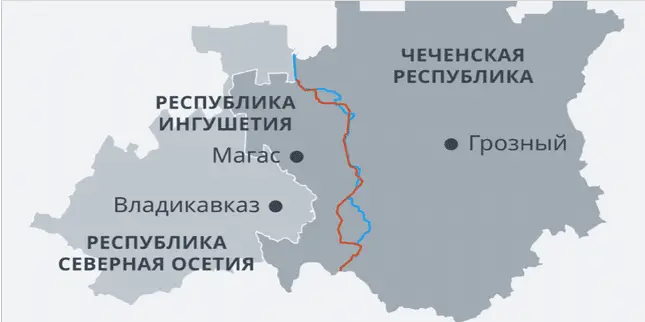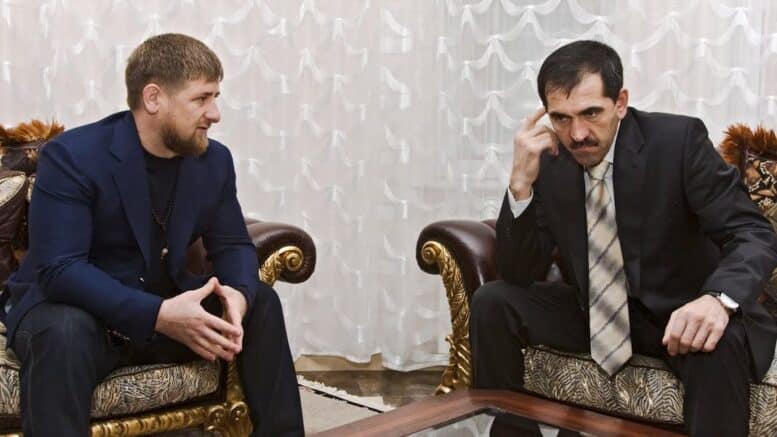Major protests were triggered in Ingushetia’s capital city by a recent land swap between Chechnya and Ingushetia. On September 26, 2018, Chechen leader Ramzan Kadyrov and Ingush leader Yunus-Bek Yevkurov signed an agreement to transfer about 103 square miles of Ingushetia’s territory to Chechnya in exchange for about four square miles of Chechen territory.
Although the North Caucus region has historically been a restive region, it has been largely quiet since the end of the Chechen Wars at the turn of the century. Large protests in modern Russia are generally rare. However, an estimated 10,000 people protested in Magas, a city with a population of just 8,800, while maintaining the support of most local police and officials. Thus, this is an event of significance in modern Russian history.
Moscow’s “power vertical” in which all major decisions are expected to be approved by federal authorities, is also in play as Chechnya and Ingushetia have been allowed to reach their agreement without formal federal action. There are multiple other territorial disputes between Russia’s federated entities and disputes between territories and the federal center on multiple issues ranging from education policy to taxation. Thus, similar conflicts could be expected to arise throughout the Federation if regions see this as a precedent and begin demanding more autonomous power.
Historical Context
Both the Chechen and Ingush people derive from the Vainakh people of the North Caucasus. They have spent much of the past few centuries with strong and not uncommonly violent independence movements – first against the Mongols and then against various Moscow-based states.
During the time of the Soviet Union, Chechnya and Ingushetia were consolidated into one region and most of the local population was forcibly deported to other Soviet regions by Josef Stalin, who accused the entire ethnic groups of treason and sedition. They were allowed to return under Nikita Khrushchev in the late 1950s, but found their homes occupied by mostly Russians, Ukrainians, and Armenians who had been settled there by Stalin in their place. The Ingush and Chechens were forced to rebuild and remained generally poor in their homeland.
After the fall of the USSR, the two republics separated into the Republic of Chechnya and the Republic of Ingushetia. Chechnya then fought the Chechen Wars with Moscow soon after. Meanwhile, the Ingush fought a bloody war with their western neighbor, North Ossetia, over a large piece of land that was given to the North Ossetians after the initial Stalinist deportations. The Ingush lost this war and have remained largely peaceful since, although there is still a sense of being historically wronged.
Further, border negotiations with Chechnya after the initial separation stretched into 1993. However, the Chechen side was never satisfied with the delineated border. Current Chechen president Ramzan Kadyrov has sited Soviet maps from 1934 and other documents as confirming that all of the Sunzhensky District, Ingushetia’s single largest district, as well as parts of Ingushetia’s Malgobek belong to Chechnya. These claims have also, of course, caused concern in Ingushetia.
Ingushetia is Russia’s smallest and poorest republic. While Chechnya has famously received a disproportionate share of federal funding for many years, Ingushetia has received relatively little help. While Chechnya’s leadership has been boisterous and demanding, Ingushetia’s has been relatively meek and obedient. To deal with the region’s continuing problems with radical Islamization, Ingushetia has attempted to create amnesty programs while Chechnya has relied on military raids and public humiliation. Thus, within Ingushetia there are feelings of having been forgotten by the federal center and there are multiple reasons to fear and expect Chechen encroachment.

Map of changes to the Ingush/Chechen border from dw.ru.
Policy
The above map shows the new border delineation (red) superimposed on the existing border (blue). The exchange heavily favors Chechnya, which would receive about 26 times more land than it will give. Reactions from the Ingush people have been largely negative. In addition to disproportionality of the trade, Ingushetia would lose farmland and oil fields in the north and mineral and timber resources in the south while gaining two small tracts of mostly mountainous territory. This will almost certainly have negative impacts on the already poor republic’s economy.
In addition, the deal was accepted in a highly obscure and possibly invalid manner. The public found out about the deal only after it was apparently already in force. The parliamentary vote that supposedly ratified it was ordered swiftly and in secret. Further, although the official result says that 17 MPs voted in favor of the deal, 4 spoiled their ballots, and 4 voted against it, four MPs claim that these official results are falsified. They say that only 4 MPs voted in favor of the deal, 4 spoiled their ballots, 15 voted against, and 1 abstained while the secretive nature of the vote ran against Ingushetia’s constitutional norms. The deal was announced only after Chechen forces were spotted in what was thought to be the Ingushetian side and then the only information published on what land was at stake was given as a series of map coordinates. The above map was created by German cartographers working from these coordinates.
вот вам фотография с автобуса, на которой можно разглядеть «пару десятков» протестующих pic.twitter.com/rX7VhMatxZ
— Liza Fokht (@lizafoht) October 5, 2018
Above, a photo of the meeting showing hundreds of people protesting from BBC correspondent Liza Fokht. The national news in Russia has downplayed the scale of the protests.
Further, on October 30, 2018, the Constitutional Court of Ingushetia ruled that the land swap was unconstitutional as it requires a public referendum and not just a parliamentary vote. Ingushetian leader Yevkurov responded by submitting an official request for the decision to be reviewed by Russia’s Federal Constitutional Court. There is also debate surrounding whether regions need federal approval to determine their shared borders or if borders can be determined by inter-regional agreements.
The Russian Constitutional Court ruled on December 6th that the Ingush court had no jurisdiction in the matter because the agreement was already in force and, because the border was actually being detirmined for the first time, that a referendum was not needed. Referendums are only needed when the border is changed. The court also ignored one of the main arguments of the court and the case, however, and said nothing about the vote tally never being confirmed, as required by law, and possibly being falsified. Meduza has an excellent extended summary of the case here.
Both leaders have declared the case closed based on the Russian Consitutional Court’s decision – although the Court admited that its decision does not actually legally overturn the regional court’s decision according to Russia’s federal structure.
Protests have apparently stopped in the two days following the court ruling. However, additional protests can’t be ruled out and some civil society organs are still pressing for the agreement to be reconsidered including, interestingly, by a Sharia court.
Regional authorities made some attempt to both hinder and co-opt the protests that were held. These included negative moves such as placing a moratorium on protests (which was observed by the protesters) shortly after the first large protests began and slowing or stopping Internet access in the capital city to try to hinder organization (younger protestors apparently found ways to set up local networks and largely get around this). Positive moves included holding public meetings with experts and reported private meetings with protest leaders and Yevkurov. Relations with protestors were largely in line with Yevkurov’s relaxed attitude to rule: requests for protest permits were granted and police were generally supportive of the protests. A harsher response would likely have proved unwise. While a few thousand people protesting in a city of millions like Moscow can be written off as a fringe movement, a few thousand appearing in Ingushetia’s much smaller cities is much more indicative of wide public support. A harsh or violent response would be more likely to increase support and lead to escalating violence.
Of greater interest is the lack of comment on the issue from the executive and legislative branches of the federal center. President Putin has only advised Yevkurov to maintain order using dialogue rather than force, which is likely what Yevkurov would have done anyway. The additional secrecy of the issue from the federal side has led many to assume that Kadryov, the leader of Chechnya must already have a tactic agreement with the Kremlin in pushing the deal forward. The Kremlin’s lack of comment is likely being done to prevent the incident from becoming a precedent by assuring that a sense of confusion is maintained as to how the deal was formulated. It’s also not believable that Yevkurov would have accepted such an uneven deal without considerable force applied. The costs to him in political and economic capital will be enormous.
9-й день митинга. На митинге присутствуют пара десятков человек.. pic.twitter.com/CHhh545i9u
— Ridzhalu (@ridzhalu) October 12, 2018
Above: A tweeted aerial photo of the 9th day of the protests in Magas. The population of Magas in 2018 is estimated to be only 8,771 people, making this attendance quite surprising.
Conclusion
Overall, the opaqueness of the land swap and its disproportionality in the amount and value of the land awarded have been the main drivers of public discontent in Ingushetia. There is no clear reason as to why Ingushetia would agree to this deal unless pressure was applied. Chechnya has likely pursued the land swap as a way to fulfil policy goals long vocalized by Kadryov and to gain more power, wealth, and regional influence. The Kremlin’s motivation is also opaque – but it would appear that Kadryov is being allowed to pursue his policy goals while the Kremlin attempts to minimize repercussions to the federal center.
Moscow’s relationship with Chechnya is closer than that with Ingushetia and, as the Ingush continue to receive fewer federal subsidies and feel that their land continues to “shrink,” the Ingush public is likely to be wary of giving up any resources they currently hold. The continued widespread public support for the protests poses a challenge to the authorities involved. The protests are not likely to abate as both dignity and economic interests are seen by the public to be at stake. They also cannot be put down with force without possibly escalating the situation to a wider conflict in the Caucuses – something the Kremlin is overwhelmingly likely to avoid. The most direct solution to the public discontent would be reverse the land swap and maintain the status quo. However, without knowing how the original land swap was negotiated or what other interests or even interest groups may be involved, it is almost impossible to know what solution may, in the end, be best for maintaining stability.



